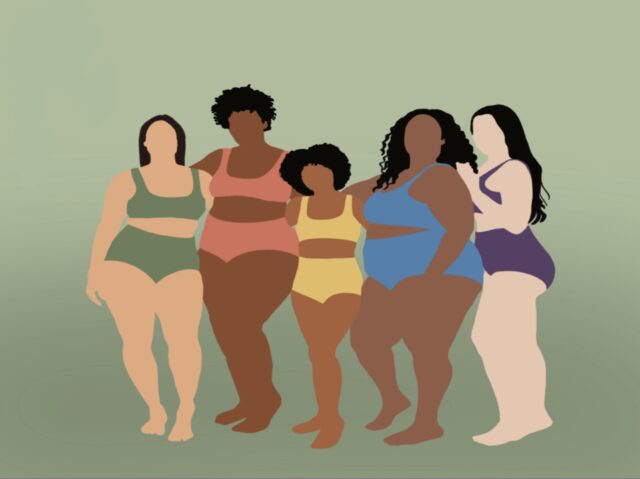Have you ever resorted to traditional Kurtis and palazzos because western wear was too tight for you? Did you go to a plus-size Vero Moda section to only find clothes on the corner shelf in black colour? Did you sigh when your friends bought affordable clothes in the Sarojini market but you were left choiceless? “Madam ye aapke liye nahi hai” is a common sentence for a chubby shopper.
Plus-size fashion has been capitalised for profit by fashion brands, influencers and media in recent years. The models at plus size fashion shows mostly have an hourglass figure. Often magazine covers edit the loose skin of models and contours the body to provide a “graceful” image. Where do the lower-class, caste and differently-abled plus size women lie in the capitalist structure?

Categorisation Of “Plus Size” Clothing
Mostly plus-size clothes are kept in the corner in stores. These clothes are not put on the same shelf as other smaller sizes. Many women find it very uncomfortable asking about the “plus-size” clothes section to the store workers. They feel marginalized from the direct gaze of shoppers and workers when they mention the size.
Brands and companies selectively promote plus size fashion on women’s day and during collaboration projects with a big celebrity. There is less accessibility of bigger clothes in the market and mostly limited to urbanscapes. The cost of buying clothes in a larger size is more compared to smaller sizes.
Gendered Culturalization Of Fashion
Local sellers will offer you a choice on traditional wear but not western. Covered traditional clothes in India are associated with the image of sanskaari women. Even if chubby women decide to explore western wear, their families obstruct it. Indian men choose mostly leaner women for marriage. No one would choose a “fat” woman for marriage if they see her wearing tight jeans that show her thick thighs or belly.
Also Read: Nike’s ‘Plus Size Mannequins’ Is A Progressive Step Then Why The Backlash?
Conflict Of Colours And Shapes
Plus-size western clothing is more in the shades of dark colour like black and grey or occasionally white. The illusion of a thin body is supposed to be created with these colours. The brands that sponsored inclusive fashion indirectly are normalizing a “graceful” leaner image on the bodies of plus size women. A person can willfully have a choice to wear monochromatic coloured clothes. But many are willing to have more colours or prints in their clothing.
The diversity of choice for plus size fashion is diminutive. Clothes do not cater to different shapes of bodies. Most clothes are either curvy and tight, cylindrical or extremely loose. The freedom to iconize one’s own style with comfort is very limited and exhaustive.
Shall Capitalistic Feminism Be Stopped?
The feminist movement expanded during the industrial revolution for the pursuit of economic agency of the woman. From women wearing pants in the 20th CE to the women demanding pockets today, capitalism and feminism have interconnected many times. Plus-size fashion indeed needs to be marketed and made widely accessible to the people.
In the concentric circle of power relations, one needs to stand in the centre and uplift those standing at the corners of society. Although polished curvy models have been marketed more, it has given feminism and body positivity a chance of expression. Now it is required to move the women of larger bodies of different shapes, communities and spaces to the centre.
Fashion acts both as a personal and socio-political statement. It leads to the creation of identities and formulates the independent agency of a person. Hoping for a brighter future with more inclusive and abundant choices in plus-size fashion.
Image Credits: Google Photos
Source: Author’s own opinion and Glamour
Find The Blogger: @debanjalidas15
This post is tagged under: plus size fashion, capitalistic feminism, feminism, vogue, Indian fashion, Indian plus size fashion, cosmopolitan India, western fashion, Anita Dongre, Myntra, Ajio, Lakme Fashion Week, India’s nest top model, Kusha Kapila, Payal Soni, Anjana Bapat, Neha Parulkar, Varshita Thatavarthi, Aashna Bhagwani.,Anil Pamnani
Other Recommendations:
Sumedha Salian Is Breaking Stereotypes By Being A Proud & Successful Plus Sized Model